The Traditional Music of Kashmir
In the present study, the traditional music of Kashmir has
been divided into the following categories:
1.0 Songs sung by Women Folk
Vanvun, Veegyavachan, Van, etc. are some of the folk songs
sung by the women folk of Kashmir. Such types of songs are sung at the time of
festivals, marriages, etc. and even at the time of death. The lullaby, which is
sung all over the world, is also sung by the women of Kashmir by the name of
Lalnavun. Another type of music is Hikkachi, where the girls in Kashmir get
together and sing. Such songs are full of love, affection and warmth.
1.1 Vanvun
Vanvun played a leading role in maintaining the continuity of
our culture from the vedic period through the Ramayana, the Mahabharata and
Shrimata Bhagwat, till the present day. Hindu Vanvun preserves our faith in
spiritual and ancient beliefs. Besides, it provides religious fervour and divine
grace to the occasions as we welcome Lord Shiva and Parvati to participate at
the outset of every ceremony.

Meaning: Vanvun
is a prayer in the form of folk music. It commences with a prayer to God. The
results are obviously auspicious, blessed by mother goddess Bhawani. Not only
this, the subjects of Vanvun also refer to the event of the Vedic period. The
customs till date are followed accordingly. For example, in Vedic period, when
Goddess Sinnavali's marriage was performed. God Poosha had prepared a beautiful
headgear to decorate her head. This was called 'Kapal-apush' in Sanskrit. Lord
Indra, beautifying it further, had wrapped a white strip of cloth around it.
This custom prevails among Kashmiris as a compulsory item of marriage even
today. 'Kalpush', in Kashmiri, is 'Kapal-apush' in Sanskrit and the white
twinkling strip is 'tarang-kor' in Kashmiri.
This ancient reality, which might have been forgotten in five
thousand years, is alive in the following lines:

Meaning: Vedic
God Pushan himself prepared 'Kapalapush' and decorated it for the head of
Sinnavali, but in your case, your father and mother have put it on your head.
The above mentioned lines have been addressed to the bride.
Researches are proving the fact that the Kashmiri language, culture as well as
religious ceremonies have a direct bearing on the speakers of Rig-Vedic
language. Vanvun, thus, is the pure reflection of the same and has been
preserving the language and culture for generations to come. In the
pronunciation of Vedic language with the use of uddatta, anudatta and swarit,
every vowel and its following consonant preserves its pronouncing capacity. The
wonderful thing is that the technique with which uddatta, anudatta are used for
modulation in chanting of Vedas, is the same as used in Vanvun singing. It is
proved today that this style originated four thousand years ago.
Muslims have separated themselves from Hindus in their style
of Vanvun singing. Among Kashmiri Hindus, a medium tone is used. It is sung in
chorus form. Its soothing melody envelops the whole atmosphere with continuous
peace and religious fervour. There is no element of tribal music in it. Both
Hindus and Muslims use the same poetry, but the former use the classical mode
and the latter the tribal. Muslims change words here and there to separate it
from Hindu Vanvun. They sing fast and sometimes very fast. The examples of both
are given below:
Hindu pattern of singing (with the use of uddatta, anudatta
and swarit):

Meaning: O
son-in-law and his father, why did you not come, where we held a gold crown
on our heads?
Muslim pattern of singing:

Meaning:
O son-in-law and his father, why did you not come, when we had gold on
our `dastar' (headgear).
Among Hindus, vanvun performers sit in a round pentagon,
hexagon or nonagon form and sing vanvun suiting the ceremony. First line is sung
by some respectable old woman (sometimes, a professional singer), who sit, on a
slightly higher pedestal. The line is repeated by other women. The alleviation
of the tone of the singing patter is maintained throughout its singing,
in accordance with the modulation, according to uddatta, anudatta and swarit
avarohana.
The series of Hindu vanvun begins from the time when a girl
expects a child and during sixth and seventh month of her conceiving. When she
carries curd and other gifts to her in-laws. This ceremony is called "Pyav"
in Kashmiri language. Milk and curd are considered to be auspicious in Kashmir.
Then on the seventh or eighth day after the delivery, a social function is held.
It is called 'Shran-sunder' (bath beauty). During the function, a birch leaf is
lighted and a folk dance is organized, where 'Shokt pansund' is repeated that
means dynasty may again be blessed with a son.
It is followed by singing vanvun:

Meaning: As
you were born, I cooked delicacies in lots and invited palmists and pandits.
Or

Meaning: For
your birth, I observed fast on the fourth day of Vinayaka, which fell on Sunday:
After your birth, I made a thorough search and got an auspicious name for you.
After the birth ceremony, comes "Zarkasaya" (Mundan).
Zarkasaya is originated from Jatarushkasan in Sanskrit, i.e. removing hair and
making the child bald.

Meaning: After
choosing a pious day, it was decided to remove your locks. We are singing vanvun
for blessing you. O live long child.
In Kashmir, the hair of only the boy child is removed. On the
eleventh day, after the birth of the child, another ceremony Kahanaethur is held.
It is christening of the newly born. Yagya is performed. The infant is placed
near it and he or she is made to taste pure ghee or honey. This way the impurity
of birth is driven away. Parents embrace the child, give a peck on its forehead
and welcome with flower petals.

Meaning: I
have made a thorough study of 'Brahaskatha' (Book of palmistry) for choosing
a name for you. Your name is thus, a blessed one. I will set gold and pearls on
your name.
The quantity of Hindu vanvun poetry is much more than that of
Muslims.
An important ceremony that follows is yagnopavit, known, in
Kashmiri, as 'mekhal'. In present times, Vanvun singing is not prevalent in the
above mentioned ceremonies. It has two reasons: first, Vanvun singing is not
possible by every woman of Kashmir. Secondly, due to the ignorance of its
historical and spiritual value, people spare no time to sit and enjoy Vanvun
singing. But 'mekhal' and marriages are not possible without Vanvun even today.
On these occasions, the old women, who have the proficiency, and are in demand,
enhance the grace, by their performance.
Kashmiri 'mekhal' and marriage ceremony-vanvun can be divided
under ten headings:
1. Garnavaya (house cleaning and washing).
2. Dapun (personal invitation of guests for the
approaching function).
3. Manzirath (henna dye and night singing).
4. Kroor (after a white wash flowery decoration at the
main door).
5. Shran (sitting on stool and dripping milk, curd and
bathing).
6. Devgun (welcome to Vedic Gods).
7. Varidan (gifts to the relatives)
8. Yonya (holy fire).
9. Tekya Narivan (holy mark on the forehead and sacred
thread tied around the wrist).
10. Kalash Lava (after the worship of Kalash, sprinkling
of water).
1.2 Garnavaya Vanavun

Meaning:
I salute the Ganga, which originated from the locks of Lord Shiva. While
proceeding towards the earth, Brahma, Vishnu and Triloki lords accompanied Ganga.
Ganga was followed by fairies from the heaven singing melodious song. I salute
that Ganga, which flows from the locks of Lord Shiva.
1.3 Dapun Vanvun
After house cleaning, the lady of the house goes to her
parents' home. A big feast is organised by her parents, when she goes to invite
them.
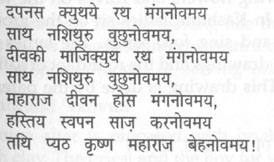
Meaning: I
have ordered a 'rath' for Devaki, the mother. She has to go to our parents'
home to invite them to attend the marriage. I have consulted Nachhpatrika for
choosing an auspicious day for the same. I have ordered a rath for the lady who
is like Devaki, the loving mother of Lord Krishna. I have brought the rath from
the king, decorated it exceedingly and made my son, who is like Lord Krishna to
me, sit on it. It was all done according to Nakshatrapatrika.
1.4 Manzi Vanvun

Meaning: All kith and kin have been
gathered. Ganga, Yamuna and Saraswati rivers have arrived. King Vasudev's
family members have all been collected to attend the 'mehandi raat' of Lord
Krishna. Goddess Ragyna arrived from Tulmula. The henna flower has grown in
the pond of Tulmul which is the garden of Gods.
1.5 Kroor Vanvun
The tradition of drawing flowers and leaves on the walls is
very old in India. In Kashmir, ladies sit on the ground near the main door and
sing folk songs. The ladies use seven colours in their drawings and the round
lot of saffron is put in the center. This drawing is done by the paternal aunt.

Meaning: I
have drawn flowers and leaves with seven colours on the main door and on the
auspicious day, put the round saffron dot in the center.
1.6 Shran Vanvun
In Kashmiri language, its synonyms are vuz-shran or gaud
shran, which means energetic bath or dripping of water on an idol. The boy or
the girl is made to sit on a platform. Four small girls hold the four corners of
the white thin cloth and spread it over his/her head. The vedic mantras are
changed, after which he or she proceeds for the bath with milk and water. He/she
is made to wear new clothes and sit near the altar of the yagya to give
offerings.

Meaning: Maternal
aunt has decorated the place for bathing. Shri Krishna has to take the
beautifying bath.
1.7 Devgun Vanvun
Devgun is originated from 'devagaman' in Sanskrit, which
means the arrival of God. It is held one day before marriage or Yagnopavit.
On this day, vedic yagya is held. After the bath, the bride,
bridegroom or the lad (in case of Yagnopavit), proceeds for the offerings near
the yagya. This ceremony is called 'Devgun'.

Meaning: You
are looking like the sun, risen from the East in this dress. I salute you
from a distance, Brahmachari (i.e. religious student of serving celibacy).
1.8 Agnikund Vanvun
A huge altar is prepared with bricks, which are pasted with
clay. The priest and the boy for yagnopavit sit around it. Fire is lighted for
one night and a day. Offerings of dry fruits, flowers and ghee are made.

Meaning: I have
used bricks of gold for raising the platform, for lightening the fire for
yagnopavit.
1.9 Yagnopavit Vanvun
In Yagnopavit ceremony, the main function is garlanding a
child with the thread called 'janeu' in Hindi, which is made of cotton thread.
The significance is that after this, the boy becomes a Brahmin. The women get
emotionally lost in singing the rhymes for this.

Meaning: The cotton plant (out of which, the
sacred thread was made) was sown with pious, benevolent mind as was desired by
Lord Krishna.
The boy acts as a bhikshak (beggar) and begs for the sake of
the family priest. It is called 'abhed', which in Sanskrit means without any
feeling of difference. This collection serves as the livelihood for the priest
and for his study purposes. The priest persuades the next generations to follow
suit.
At the end of the religious function, there is a folk dance.
1.10 Marriage Vanvun
On the marriage ceremony of the boy and the girl, house
cleaning and invitation ceremonies are held in the same way in the case of
Yagnopavit. But other ceremonies differ and their subject of vanvun changes
according to the occasions.
a. Masmuchravun (hair opening of the marriageable girl)
b. Manzirath (henna dye)
c. Devgun
d. Lagan (Kanyadaan)
Mehandiraat and devgun ceremonies are performed at the time
of marriage. But the subject of mantras as well as vanvun pertains to the
marrying boy or the girl.
It is necessary to sing Vanvun on Devgun, which follows
mehandiraat. It provides assistance to the celebration through human sensation
and expression of doubt and feelings on the occasion as the girl has to go to
strangers' house. Among Kashmiri Hindus, at the time of vedic yagya (devgun),
red cotton thread is put in the hole of the ears of the girl to hang the
hexagon-shaped gold ornament, which is called 'dejhor' in Kashmiri language. In
Vedic language, it is called 'aditva-hora'. It indicates lucky future of the
girl.

Meaning: Dejhor
was made in Vijeshwara. Max, she be blessed.
Then comes the turn of 'dwara-puja' (prayer at the door). The
bridegroom and the bride stand at the door. Vedic chantings follow. The father
of the girl welcomes the father of the boy by saying 'swagatam bhava' (I welcome
you). The father of the boy answers 'suswagatam' (I also welcome you). This
enchanting moment is accompanied by a vanvun.

Meaning: Today, for the wedding
of Rukmini, the daughter of Bhishmak, i.e. Srikrishna, the dear darling of
Vasudeva has arrived.
It is followed by the marriage ceremony.
In almost all other Hindu communities, bride and bridegroom
touch the feet of their parents after the marriage ceremony to get the
blessings. In Kashmir the bride and the bridegroom are worshipped as Shiv and
Parvati at the end of the marriage ceremony. The custom is that the bride: and
the bridegroom are made to sit facing each other and a shawl or preferably a red
coloured cloth is spread over them. All the family members and the relatives
sprinkle flowers on them. This is called 'posh puja' or the worship with flowers
on them.

Meaning: Dharamraja has arrived with religious
value of 'Dharama’ along with Ganga Sagar and Vitasta to worship Shiva and
Shakti. Today Shiva and Shakti are worshipped as a pair.
1.11 Muslim Vanvun
Muslims do not follow the practice of singing vanvun in the
same fashion as the Hindus in Kashmir do. Their pattern of singing is different.
They divide themselves into two groups. One group sings a line, which is
repeated by the other.
At the end of second half of the fourteenth century. Kashmiri
Hindu civilization underwent a drastic change. The culture and tradition got a
jolt. Vanvun was no exception. Muslims changed the subject and the style of
their vanvun from the original.
They sing in fast speed and sometimes get even faster. They
do not have that consistency, which Hindus have in vanvun singing. They
generally sing standing. Muslims form two groups, facing each other. One group
consists of two rows. First row consists of elderly women. The second row keeps
standing and the first row holds each other's back. The second row comes forward
with one foot and goes back with the other singing vanvun. This type of singing
is prevalent in Kumaon and Garhwal hills. The style and the way of tying a
printed scarf around their heads is also prevalent there as is prevalent among
Muslim women of Kashmir.

Meaning: Have control over the key of the car
and drive the same slowly to his in-law's house.
At the time of birth, Muslims celebrate 'shadiana' to bless
the child. The newly born child is taken for bath. Through the left ear, 'azaan'
and through the right, 'tak baar' is read. 'Azaan' implies welcome to the child
and 'Takbaar' reminds the child of the inevitable death.

Kashmiri Muslims hold 'Zarkasy' (originated from
jatanishkaran, in Sanskrit) in Kashmir. Seventy five percent Muslims in
Kashmir are converted Hindus, which is why, some functions are common. Muslims
remove the hair of the boy or the girl child after a year and a half of the
birth. 
Meaning: I have sought auspicious
day for your hair removal. May God bless you with long life.
The most important celebration among Muslims is circumcision.
They arrange feasts and after the religious ceremony sing vanvun. Among Muslims,
vanvun, sung during marriages, comprises of:
a. Tomul-cchattun (rice cleaning)
b. Mehandiraat (henna dye)
c. Masmucchravun (opening of the hair of the girl before
marriage)
d. Yenivol (arrival of the groom and the guests)
At the reception of barat, ladies sing vanvun with great
enthusiasm.

Meaning: Nightingale, you
sing enchantingly in the center of the flowery garden. The bridegroom is
arriving.
It will be right to say that nature provided its charm,
delicacy and human touch to the music of Kashmir.
Unfortunately, these days, some absurd contents are being
added to Hindu vanvun like, 'the bridegroom arrive late' or 'our girl is
educated', etc. ,Such meaningless additions have brought down the value of
vanvun. Thus Hindu, Vanvun is deviating from its purpose and religious fervour.
We have to save it and revive its grace.
1.12 Veegya Vacchan
'Veegya vacchari has originated from a vedic word, 'vishesh
yog vacchan', i.e. to be sung on a special occasion. It is sung by Kashmiri
Hindu women at the time of Yagnopavit ceremony or at the time of marriage
ceremony. When the bridegroom leaves for wedding along with the wedding guests,
a round shaped drawing of various designs, in seven colours, is prepared on the
white washed piece of ground in the courtyard. It is called 'vyug' in Kashmiri
and after the completion of yagnopavit, the boy is made to stand on this and is
fed with sweets, after which he is taken to the river for a bath and evening
prayers. At his departure, the women of the house stand in a circle, make the
lady of the house stand in the center and revolve around her, drawing and
singing.

Meaning: After performing
yagya with vedic mantras, the lad has departed to the banks of the river for the
bath, after the religious observance. He has been carried by his maternal uncle.
The lady of the house (supposed to be the mother of the boy)
dances and sings:

Meaning: God bestowed me
with the son. He has been brought up by his grand mother. By holding the lad in
my lap, my ribs are tired so much so, that they are almost broken, but now thank
God, they are in order again.
The dance movement and singing continues till the women feel
that the bath of the lad on the banks of the river is over. They then start the
next series:
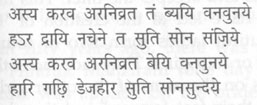
Meaning: We
will sing arnivrat and vanvun. Sharika, the lady, has come down to dance-a
golden dance. Sharika should have a dejihor (aditya) to wear.
When the boy leaves for the wedding, the same custom is
allowed. Then mother, sister(s) and other women sing:
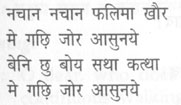
Meaning: Constant
dance has bruised my feet. I should get a gift of a dress. A sister has great
expectations from a brother, so I should have a new dress.
1.13 Ruf
'Ruf' is a very interesting and emotional type of folk dance.
It is called 'Row', in the capital and 'Ruf' in villages. It is directly related
with spring. On the basis of the climatic conditions, there are four seasons in
Kashmir. Every season lasts for three months. At the outset of spring, Kashmiris
entertain themselves by dancing and singing. This practice was prevalent even in
the ancient times, which is mentioned in Nilmatapurana. It has been proved
that 'Ruf' has been inspired by the bee and is the imitation of the lovemaking
of the black bee. 'Ruf' might have been originated from 'dwarf dance', of vedic
language. In Vedic language, it means a bee, which further developed as Ruf. In
spring, autumn seasons, the black bee comes near the bud but does not touch it,
as it seems too shy It revolves around the bud for a long time, creates a
romantic mood by moving back and coming forward again and again. At last, the
bud yields and accepts the offer. This movement of the bee might have led to the
creation of 'Ruf'.
In 'Ruf' beautiful ladies form two or four groups, consisting
of three or four girls. They face each other. Each girl puts her arms on the
arms of the other girl. All the girls jointly bring their feet forward and then
backward. This is how the dance proceeds. The songs are in questionanswer
form.
In Kashmir, in far-flung villages, usually two groups are
formed. One group questions and the other answers, musically, while dancing 'Ruf'.

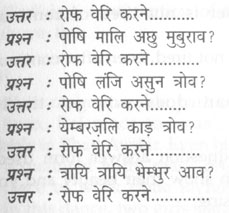
Meaning:
Q.: In the garden
of flowers, did the black bee arrive?
Ans.: It has come to perform 'Ruf' dance.
Q.: Did the flower open its eyes?
Ans.: It opens its eyes to perform ‘Ruf’
dance.
Q.: Did the flowery branch, full of blossoms, smile?
Ans.: The bee has come to perform 'Ruf' dance.
Q.: Did the flower yawn and stretch its limbs?
Ans.: The bee has come to perform 'Ruf' dance
Q.: Did the bee arrive slowly and consciously?
Ans.: It has come come to perform 'Ruf' dance.
About fifty years ago, there was a custom among Kashmiri
Hindus, Manzirath (one day before marriage, when henna was applied on the bride
or bridegroom's hands), Lalleshwari's vakhs were sung in question answer form in
the 'Ruf'.

Meaning:
Q.: O dear, who does not get tired, even after
continuous walking?
Ans.: O friend, water is not tired of
continuous flowing.
Q.: O dear, who is not tired, even after continuous scandalizing?
Ans.: O friend, man does not get tired
scandalizing.
Another example of question answer form used it 'Ruf' is
given here. Women show their beauty and youth in colourful dresses and sing:
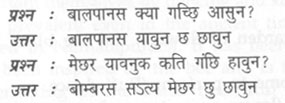
Meaning:
Q.: What is
needed in maidenhood?
Ans.: In maidenhood, youth is to be enjoyed.
Q.: Where is the sweetness of youth to be shown?
Ans.: Sweetness
is to be enjoyed with the bee.
Muslims have their separate type of 'Ruf' dance, which they
display on their Islamic festivals.

Meaning: My friend, Id has come, Let us
go at a slow pace to the Idgah.
The tradition of dancing and singing has been an ancient
practice in Kashmir.
Nilamatapurana has mentioned it at several places.

Meaning: This
public entertaining festival should be organized with dances, sweet songs and
musical instruments.
'Ruf' is a continuation of the tradition, indicated in the
above line.
1.14 Hikat
'Hikat' is an inseparable part of 'raas'. We can even call it
a form. Reference to 'raas', prevalent in Kashmir, is available in Bhatt Avatar.
Even his predecessor, Nund Rishi, was acquainted with 'raas', originated from
'hi-krit', i.e. any piece of work done joyfully.
In this dance, two girls stand in a circle in pairs facing
each other with bright sticks in each hand and strike at each other's stick and
sing:

Meaning: Let
us get together and dance 'raas'.
While striking, the speed of the singing gets faster, after
which the girls throw the sticks and one girl holds the right hand of the other
girl and the left with the right. The girls then drag the weight of the body
towards their backs, touching the fingers of the feet of the girl opposite, with
hers. They start moving in a spherical manner to the slow music. Soon, the speed
of the movement of the body as well as of the music gets faster. Again, the
speed gets slower and the girls lift the sticks and start striking and singing
simultaneously.

Meaning: Come friends, we will hold 'raas'
dance and play 'lal bandha' game.
There is another form of 'hikat' that is hikachi, which is
performed by small girls. 'Ch', in Kashmiri language, denotes feminine gender.
Hikachi gavun is a song, which is sung by small girls, while playing the hikat.
This game can be played on any occasion, season or festival.
Two girls hold each other's hands in the form of a cross. The
game begins with question answers:
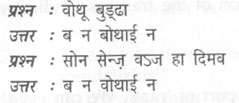
Meaning:
Q.: Oldman stand
up
Ans.: I will not.
Q.: I will give you gold ring?
Ans.: I will not.
At the end of long dialogues of this type, the girl hold the
balance of their bodies backwards, touch each other's feet and sing.
'Hikat' is common among Hindu and Muslim girl. Though 'hikat'
songs are not available in large number yet they hold great significance. They
do not have an systematic ideas, yet some of them are full of seriousness of the
theme.
For example, the following song beautifully presents the
future imagination of a girl, in her early teens:
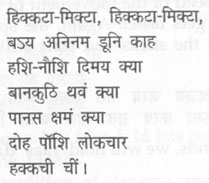
Meaning: These
lines reflect the romantic feelings of the girl about the future. She will be in
her in-laws, home. Her brother would come to meet her with almonds. They would
be eleven in number. Will the almonds be sufficient for distributing, eating by
her mother-in-law and herself? Some are also to be stored. Innocent dreams of
the girl have been vividly depicted in these lines. The girl does not seem to
have shed her childhood innocence.
1.15 Vaan
Vaan is a market or shop in Kashmiri language. Kalhana has
used the word 'patvan' in his Raj Tarangini, i.e. market of cloth. In Kashmiri,
the actual word for it is 'Vedan', which means crime market. It is popularly
known as van in short form. According to Hindu religion, a man goes through
sixteen rituals and 'antyeshthi sanskar' is the last among these. In Rig-Veda,
ample reference to the expression of grief, made at the time of death, is
available. In Indian culture grief songs are in practice even since ancient
times. This tradition was prevalent in civilized caste. Unfortunately, it is on
the decline.
In Kashmiri Hindus, whenever an old man or woman died, these
types of grief songs were performed, i.e. vaan singing was done. Among Kashmiris,
grief remains for ten days. In olden days, an old professional singer, who was
called 'vangarinya' in Kashmiri, came on the day of the death, enquired about
the names of the ancestors and family members etc. and sang till the tenth day.
Her body and throat used to choke with grief. The subject of the songs were in
praise of the dead and his future in Heaven.
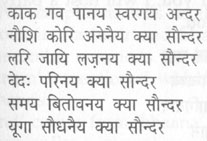
Meaning: The dead person entered the Heaven
himself. He got his beautiful daughters married, brought talented
daughters-in-law home, built nice houses and did studies of Vedas nicely, spent
whole life well and did Yoga, meditation.
1.16 Lalnavun
This is a type of folk song, which is sung to make the baby
fall asleep. In Hindi, it is called 'Lori', in English it is called 'Lullaby'
and in Kashmiri, it is called 'Lalnavur’. 'Lalnavun’ is based on Vatsalaya
Ras. It reflects mother love, which is pure. It depicts the unbroken bond
between the mother and the child. Usually, Ram, Krishna, Yashodhra and
Kaushalaya are the main subjects of Lalnavun.

Meaning: O
child, I will swing you in my lap and prepare ear ornaments for you. O my
flower of marigold, I will make a garland for you, I will host a party for you
and make 'moun' for you.
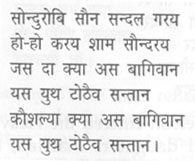
Meaning: In the above mentioned song, the
child is imagined like Krishna and Ram and their mothers are like Yashodhra and Kaushalya. In Lalnavun songs, the mother prays
for the long life of the child. These songs depict the mother's fondness and
love for the child. The main idea behind these Lalnavun songs is to make the
child sleep.
In the book, 'Thirty songs from the Punjab and Kashmir',
Ratan Devi Coomaraswamy writes about the cradle songs of the Kashmiri Lullabies.
"The cradle songs are perfect in their own way; unlike so many so called
lullabies in modern music. They could scarcely be simpler; the beautiful vowel
sounds, tune and rhythm combine to form a true croon".
2.0 Songs Sung by Minstrels
These types of songs are those, which are sung by the
professionals from the point of view of earring money. In this category fall the
songs sung by the Chhakar singers, bhands and ladishah singers and more.
2.1 Bhand Paethar
Singing and dancing by bhands has contributed a lot to the
traditional music of Kashmir from the ancient period. Not only in Kashmir, but
also in other places, bhand paethar (custom) has remained prevalent from the
very ancient period.
In Kashmir, existence of bhands has remained very popular.
Nilmatapurana tells us that bhand paethar was very famous in Kashmir and bhands
performed during festivals and other occasions. In Nilamatapurana, the word 'mandavanam'
is mentioned, which means dance and songs by the bhands.
'Bhand' comes from 'bhaana' a satirical and realistic drama,
generally a monologue that is mentioned in Bharata's Natyashastra. The Bhand
Paether is not a monologue but a social drama, incorporating mythological
legends and contemporary social satire. Born Hindus, the bhands converted to
Islam and remain very secular in their outlook.
The Bhand has to train himself, to be a skillful actor,
dancer, acrobat and musician. The leader of the troupe is called 'the magun', a
word taken from 'mahagun', a man of varied talents. He teaches his pupil the art
and expertise of their inheritance. Today, the training is non-existent.
The bhands dance to the tune of a specified 'mukam and the
orchestra includes the shahnai, dhol, nagara and the thalij. Before the Swarnai
player adopts his newly made instrument, a ritual offering is made in a 'dargah'.
The composition played is called a 'mukam and each bhand
paether has its own. The music follows a set pattern-the salaam, thurav, duitch,
nav patti and the salgah. There is a highly developed system of music based on
the classical mould, the Sufiana Kalaam with intricate and codified patterns.
The man who plays the dhol is the central figure in the
orchestra. Many tools, in various combinations, are played on this drum but
today very few remain. The nagara is an accompaniment to the dhol and the rhythm
doubles in intensity as the playing proceeds. More than one nagara is used in
the performance to emphasize the sound of the instrument. The thalij is a metal
cymbal, a little larger than those used in other musical forms. To this music,
are added Kashmiri folk songs, which are sung throughout the play.
The properties that are a must for every paether are a whip
and a short bamboo stick. The 'koodar' or the long whip as crafted from the dry
stem of the 'bhang' plant and looks like a thick rope, which is forked at its
tip. When used, it emanates a sound similar to gunshot. During the performance,
a character can be whipped a hundred times, without being hurt, because this
property does not have the impact associated with the whip; it just looks
deadly. It is used to transform all the elements that represent oppression into
strong dramatic images. In sharp contrast, the 'bans' are used by the jester or
'maskhara'. These are split bamboo sticks that make a sharp sound.
Besides these, 'kaper chadar' or sheet of cloth is also used
as a curtain. Some of the actors make their entry from behind this curtain.
With time, the music has changed and unfortunately, the
traditional 'mukam ragas' are not played as much.
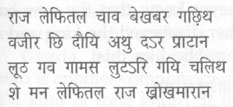
Meaning: The king is unmindfully sleeping
under the quilt. The villages have been ransacked and the king is sleeping
peacefully under the six feet long quilt.
A new direction has been made in the Kashmiri bhand paether
and the credit goes to Shri M. L. Kemmu.
2.2 Ladishah
'Ladishah' is originated from ladi and Shah. 'Ladi' means a
row or line-'Shah' has been added with the passage of time with the coming of
Muslim rulers.
'Ladishah' is a satirical song, which reflects the society's
condition. It is a type of song, which makes people laugh, but at the same time,
it is a satire on the existing government.
The singers of 'ladishah' remain in groups and carry an
instrument with them, which is called 'dhukar' or 'dhukru'. 'Dhukar' is made of
iron (1 -1.5 mtrs. long), with metal rings hanging around it. The singers wander
from village to village. They generally go to other villages at the time of
harvest to earn their livelihood.
They are satirists, who compose their songs on the spot, on
the issues pertaining to social, small and big evils. Their manner is very
humorous and entertaining, but bitter at the same time.
In the history of Kashmir, there was a king named 'Mukunda'.
His ears were very big. Thus, he wore a huge turban to hide them. This secret
was only known to his barber. Unfortunately, the barber died. As a result, the
king engaged a new one and directed him to hide the secret of his big ears. He never knew that the new barber was a
'ladishah'. The
barber disobeyed the king and the secret exposed to the public like this: 
Meaning: King Mukund's ears are of the size of
the ears of a buffalo. Ears are as big as a huge forest.
Similarly, when the aeroplane came to Kashmir, satirical
verses were composed. 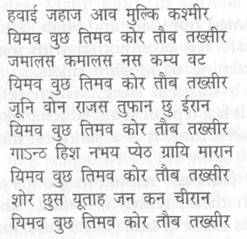
Meaning: The
aeroplane comes to Kashmir for the first time. Anyone who saw it made a hue and
cry: Nothing bad was done by Jamal and Kammal who came out to see the aeroplane,
because everyone came out from the house to see it. Whoever saw it, made a hue
and cry. The plane went circular like an eagle. Whoever saw it, made a hue and
cry. Much noise was created by the plane and the ears got hurt by the noise.
Whoever saw it, made a hue and cry about it.
2.3 Chhakar
'Chhakar' has an important place in the Kashmiri folk music
tradition. It entertains old and young ladies and gents. It may be the
originated form Rigvedic 'Shaktri' or anti-shakri rhyme. In Aryan culture,
chorus singing after deva-yagya was a common practice. But according Shri Mohan
Lal Aima, 'mantrya mand's ghada instrument originated 'chhakri'. Ghada, has an
important place in 'chhakri'. Tumbaknari is another compulsory instrument in 'chhakri'
. which is a kind of long gourd. It is open from the back. On the front side of
the tumbaknari, the skin of a cat is stuck. Usually, ghada is played by men and
tumbaknan by women. Sometimes, sarangi and rabab are also the accompaniments.
Male dancers perform dance, which is called 'back-kot' (originated from Vedic
vatkat.) 'Chhakri' has great relationship with farmers, who at a break from the
hard task, sing and dance in the evenings. 'Yagnopavit' and marriage ceremonies
are not possible without 'Chhakri'. On an auspicious day, tumbaknaris are
purchased and 'Chhakri' singing begins from the house cleaning ceremony.
The credit of making 'Chhakar' famous in Kashmir, goes to the
professional artists who, along with their full team, sing and create a musical
environment, which is full of fun and entertainment. 'Chhakar' traditionally was
confined to villages, though songs, set to 'Chhakri' music, were sung on wedding
occasions in the urban areas. The credit of popularizing it goes to Radio
Kashmir. We often watch 'Chhakar' programmes on T.V or hear it on All India
Radio, in the valley.
Chhakar' gayaki is not new. This type of folk song, has been
in practice for a long time. According to Raj Tarangini, king Bhashmakar had
made a type of folk song popular in which, utensils of clay or brass were used.
Even today, we find gaagar, chimta, matka, ghada, etc. being used as the
instruments with 'Chhakar' gayaki.
'Chhakar' is sung collectively in a group. 'Chhakar which is
sung by professionals, has only men in it. A very important feature of 'Chhakar'
gayaki is that the singers themselves play the instruments. The style of singing
such that the first line of the song is sung by the leading singer. The same
line is repeated by other members of the group. The speed of the song gets very
fast and the work get difficult to understand. When 'Chhakar' is in its full
swing, people from around get up and start dancing.
Undoubtedly, it is a very popular and entertaining folk song.

Meaning: O
lad, I will sacrifice myself for your child like actions and get lost in your
name, Ram.
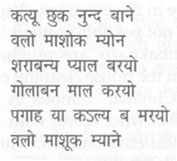
Meaning: The maiden is separated from
her lover and remembers him. "Where are you my lover? Please come to me. I
have filled the cups with wine and made rose garlands for you. Come, O my lover
or else I will die in a day or two".
2.4 Bachhi Nagma
The general meaning of the 'bachhi nagma' is adolescent
melodious voice. But in villages, it is still known by the old name 'bachhi
gyavun’ . During Pathan reign (1757-1818), the Arabic word 'nagma' must have
been added to it. So it is the mixture of 'bachhi' (originating from sanskrit)
and 'nagma' (originating from Arabic). The dress of the dancer is round and very
loose and long, upto the feet. Upto the waist, it is tight. 'Ghunghroos' are
tied to the lower side of the legs. Sometimes they keep long hair. This dress
matches the dress of a 'Kathak' dancer. Such dances are very old in India. This
has been mentioned in Nilamatapurana.
The Kashmiris have great liking for the dance and music of 'bachha nagma'.
The dancing boys are professional singers. They are booked in
advance for marriages, yagnopavit of other functions. The troupe consists of six
or seven members-One, a leading singer and others, the prayers of rabab,
sarang, etc. An atmosphere of entertainment is created by singing, the sound of
payals, the trembling and wavering movements, the actions of both hands, the
tender singing voice, by their holding the corners of long vesture from right
and left side and by variety, in expressions. Slow and melodious modulation of
music reminds of the rhythm of flowing water-falls.

Meaning: The
nightingale and the parrot are in mutual competition. Friend! Listen and see,
the parrot surpasses the nightingale in singing.
2.5 Rishi Macchar
'Rishi Macchar' has been originated from the vedic 'Rishi +
Mat + har. i.e. insane or intoxicated movements of the Rishis. 'Rishi Macchar'
is known as 'Rishi Bechhun' i.e. Rishi's begging. In ancient times, we used to
spare some time from meditation once a week and go to other villages to beg for
food in the name of God. Whatever they received as alms, was accepted by them.
They were spiritually intoxicated. Ladies of the houses name
this known as 'Rishi Macchar'. Kashmir is known as Rishivar, means the abode of
Rishis.
Rishi tradition of Kashmir has been mentioned in 203 of
Mahabharata. Kashyao was also a Rishi. Even Muslims have respect and faith for
them. Rishi Macchai Saints used to move in groups, enter the courtyard of any
house and repeat those rhymes, which pertained to the morality of life. Kashmiri
Hindu and Muslim women used to put questions about the future of their husbands
and family.
Here are a few examples:

Meaning: Rishis
are themselves lost in meditation. They pray happiness for all.
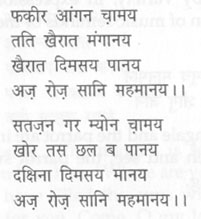
Meaning: The saint has come to my country and
to receive alms. I will offer myself. You stay over at our place as an
honourable guest. I will wash your feet myself.
2.6 Dhamaly
'Dhamaly' means leaping and jumping. 'Dhamaly' or 'Dhamali is
a holy sport in Brij in Uttar Pradesh. It is related with an exercise of Saints
who jump over burning fire. This word is common in Kashmir. When small children
leap and jump, they are directed not to do 'Dhamali', i.e. jumping. This is a
dance performed by fifteen to twenty persons. Ladies do not take part in it. The
whole team wears white cotton dress and a head gear. Two dholaks are the
accompanying instruments. When one gets tired, the other plays. The dance fully
depends on the dholak. A little fault spoils the vehicle show. The group stands
in a circle. The leader addresses them:

Meaning: O
mad (companions), give blessings.
They, then, play dholak and dance in 'raas' form and act as
if they pray to some divine power for the blessings and sing together:

Meaning: God
may bless us, you and the whole world.
Then one actor comes forward and does 'bhangra' type actions
and jumps about two meter high. Others whistle to encourage him. He is called 'Damali
Fakir'. He then sings:

Meaning: You
must offer something for the sake of Vishnu. Saints have entered your
courtyard.
At times the dancers carry about one meter long stick and
strike and counter strike. Their dance resembles 'raas'. All the ladies bring
their children to get blessings. This dance is held in spring, when rice is
sown. Their second visit begins after summer season, then they go to religious
places, grave yards, abodes of peers and fakirs and religious fairs to give a
display of their skills.
3.0 Songs Sung by Farmers
3.1 Naindai Gyavun
Naindai Gyavun is related to farmers folk songs. Naind is the
changed form of the word 'Ninad of Sanskrit'. The word 'gyavun' also has
originated from gayan of Sanskrit. India is an agricultural country. The
tradition of agricultural songs is prevalent in every state and region. The
nature of agricultural songs is joyful exciting and merrymaking. The people in
Kashmir are rice eaters. To prepare the paddy fields is not an easy task. It
requires hard labour with proper planning. Singing makes difficult tasks of the
farmers easy and enhances their zeal. After cultivation, the land becomes uneven
and soil lumps are formed. The lumps are broken and the soil is made even. The
task of breaking of soil lumps is called 'Yattpur'. After 'Yattpur' farmers sow
paddy plants. Sowing of paddy plants is called 'Thal'. When the plants start
dancing in the breeze, the farmers come back for cultivation of the soil and
weed. Making the fields suitable for agriculture is called 'Naindai'. In harvest
season which comes in Kashmir in October and November farmers have to be quick
and vigilant in harvesting and carrying grains for storing. They are scared of
the uncertainty of rains and snow. They find no breathing time in between, but
sometimes give pause to their work. They sit beneath a tree and entertain
themselves with singing. It is accompanied by 'Manjira' etc. Since these songs
sung in chorus pertain to farming, they are called 'Naindan Chhakar'. Here are
certain examples.
They give free flow to the rhythmic tones under the open sky:
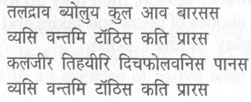
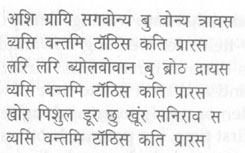
Meaning: The
seeds have sprouted. The plant has gained entity. O my friend you tell how long
shall I have to wait for my lover? The top of the plant is giving a jerk to its
blooming self. O my friend, how long shall I wait for my lover? I will water
this plant with the flow of the tears of my eyes. You tell my how long shall I
wait? Lost in the thought, of my lover, I have gone much forward while
transplanting in paddy. You tell me how long shall I wait? The fields are
slippery with wet soil. I have to press down my foot. How long shall I wait for
my lover?
The song shows the throbbing pain of an innocent maiden in
separation from her lover. The melodious style of singing makes the pain mild
and sober. Her feeling does not disturb her working. In Kashmir, in summer, it
is the maidens who go for hoeing and weeding the land for wheat, kidney beans,
etc. The weeding instruments, like the khurpi or tongrues are used on low and
high land. The work inspires them to sing full throatedly.

Meaning: Get,
up, O friend, we will go to the Kidney bean fields for weaning Unwanted plants.
May be my darling will be reminded that I am waiting. Get up O friend, we will
go to paddy fields for weaning unwanted plants.
The plugging is done at three stages: Firstly, on dry land,
then on wet land and then at the time of weeding. When farmers' maiden or newly
married daughter-in-law does the job for the first time, her parents, brothers,
sisters, uncles and aunts come to help her and all sing in one tone:

Meaning: The daughter-in-law is addressed. "Your
brother is coming along the parapet to help you. Hurry up in
transplantation". Her answer is O my brother and I will offer myself a
sacrifice for the length of your 'dussa' (a big giant shawl of 5 mtr. Pashmina).
The impact of the forced conversation of Hindus to Islam can
be traced from the following two songs sung by Muslims and Hindus.
Muslims sing:

Meaning: I have sown the paddy plants. You be
merry and go to the graveyard of Nabi Sahab to promise there to offer something
after the fulfillment of my desire.
Hindus sing:

Meaning: I have
sown the paddy plants. You be merry and go to Bhairav temple to promise there to
offer something after the fulfillment of my desire.
The occasion of merry making and melodious singing comes when
autumn, i.e. season of harvesting begins. Again the girls begin their
work of reaping and singing in their melodious voice. We remember the words of
words worth in 'The Solitary Reaper' "reaping and singing by herself"
in Kashmir, the songs have a tinge of romance.
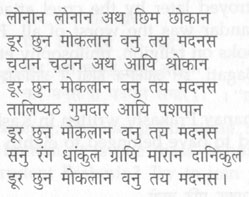
Meaning: Constant reaping has made my hands tired.
Still the field is looking bigger and bigger. Go and tell my lover, harvesting
has bruised my hands and still the field looks bigger and bigger. In the heat of
autumn season, drops of sweat are coming down from my forehead. The field yet
looks bigger, i.e. no end to work is visible. Go and tell my lover.
4.0 Religious Songs
4.1 Leela
Leela songs are the songs dedicated to God. Prayer songs in
Kashmiri were written in Sanskrit in the past which were dedicated to Shiva
Shakti, Vishnu and to Baudh Dharam. Kashmir has been the place of Rishis whose
every action was consecrated to spiritual powers. We can hear Hindus in temples
reciting the couplets from panchastavi (prayer book in Sanskrit) even today.
Reference to the devotional songs in Kashmiri has been made
by Ksemendra whose period has been calculated between tenth and twelfth
centuries:

Meaning: That old 'Guru' selected a devotional poetry
book form his native language from his personal library.
The word  in the above line proves the fact that there were
more such poems available at that time. But they were destroyed later by the
cruel attacks from outside. Sultan Sikandar was the worst of all. He burnt
ancient valuable books on religion, philosophy etc. In the words of Dr. Usha
Bagati in the above line proves the fact that there were
more such poems available at that time. But they were destroyed later by the
cruel attacks from outside. Sultan Sikandar was the worst of all. He burnt
ancient valuable books on religion, philosophy etc. In the words of Dr. Usha
Bagati

The Book 'Mahanay Prakash' written in Kashmiri by Shrikanth
is deemed to have belonged to eighth or ninth century.

Meaning: After the blessings of Guru, meeting with
God becomes easy and there is no importance of the ritual of Chaturdashi prayer.
Certain devotional verses of Kashmiri language belonging from
tenth to thirteenth century are available. They throw light on 'Pandit Kalaam .

Meaning: To attain
oneness with God is possible only by enjoying devotional songs with
concentration and by unearthly religious practices.
Next follows the period of Lal Dyad (14th century) popularly
known as Lalleshwari whose Vakhs have depth of mysticism.
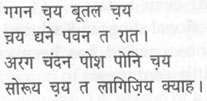
Meaning: What
should we offer you in worship? You are the sky, you are the earth, you are the
air, the day and night, you are the sacrificial grain the sandal paste, you are
the flowers, the water and all that exists.
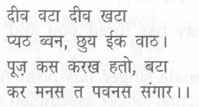
Meaning: The idol
is but stone. So is the temple from top to bottom, it is one mass. Whom will you
worship. O imprudent Brahmin? Try to join your prana with the mind.
Another poet who created history by his contribution to the
devotional music of Kashmir is Nund Rishi.
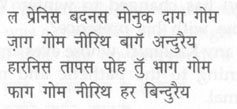
Meaning : Old
apparel of mine has received a stain. Sentient being has left the garden.
Resultantly the warmth of the sunlight of summer season has changed to winter
cold weather. I am deprived of the advantages of summer. It is a mystic
statement, meaning thereby that the sins I commit have changed the advantages
which would have been in my share to disadvantages which are due to a sinner.
At another place, he confesses that he has led a
materialistic life to the ignorance of the fact that the world was false and
artificial.

Meaning: After
Nund Rishi, comes the name of Habba Khatoon, whose singing talent
raised her to the height of a queen. Her lines are famous.

Meaning : Some
lady has lured you and you have developed hate for me.
Another famous female singer has been Arnimal in 18th
century. This intellectual singer assembled all the old tunes and preserved them
in her sentiments. These songs are the precious treasure of traditional songs
for Kashmiris.

Meaning: The
sizzling beautiful colour, which nature has in 'Savan’ (July) has changed to
winter. When will he come to bless me with his presence?
There is hardly any Kashmiri, whose eyes are not filled with
tears on listening to the pathetic and melodious renderings of Arnimal.
In Ram Leela and Krishan Leela, Kashmiri poets have
contributed abundantly to the religious poetry in Kashmiri Language. Prakash
Ramayan, Shankar Ramayan, Anand Ramayan, Vishnu Pratap Ramayan, Amar Ramayan
have a distinguished place in Leela tradition. Among Krishna devotees, the poet
Parmanand is well known. He went to the village, contacted old women to learn
the tradition which they were preserving by singing. He revived the ancient
culture and the devotional fervor, which Martand temple once had and which was
destroyed by the cruelty of foreign invaders. Parmananda realized that old women
had given patronage to it in their homes in villages. He made the most of it.
He revived it with musical tunes and paved the way for the
future Leela singers like Laxmanjoo, Bulbul and Krishanjoo Razdan. He depicted
different stages in the life of Lord Krishna, like his childhood and youthful
actions with Gopis (married women who flirted with Lord Krishna).
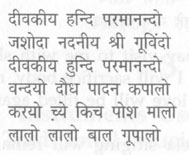
Meaning : O!
Source of joy for Devki and the son of Yashoda, I will bow before you and
make flower garden for you (The devotee has mentioned his own name 'Parmananda').
After Parmananda, the notable name is that of Krishna Das,
who was a composer and a singer of Leelas. Following devotional lines are on
everybody's lips:

Meaning : I
have come to worship before your lotus like feet.
The tradition of Kirtan (singing devotional songs in chorus)
in temples by males, females as well as children. is old in Kashmir. Songs
devoted to Ram and Krishan are sung regularly. Anand Ji's poetry pertaining to
Ram's childhood is well known:

Meaning : O
Ram, I will sacrifice my self for your childhood actions.
Kashmir is known for Shaivism, Amarnath, Harmukh Ganga,
Mahadeva are ancient pilgrimages, where devotees go to pay homage. The following
lines are devoted to Shiva:

Meaning: O Shiva,
pay visit to me with slow steps with our lotus like feet. I will sacrifice body,
mind and all. The dry pond of my love will be filled again, if you come.
The tradition of Leela singing will remain intact. Though
Kashmiris have been displaced, their listening to Leela Cassettes and
assembling at respective regions and singing Leelas in unison on festivals like
Navreh and Sonth(spring festival of Kashmiris).
| 













































































No one has commented yet. Be the first!